Environmental Science: Introduction to Botany - Species Survival
VerifiedAdded on 2020/10/23
|13
|4085
|434
Report
AI Summary
This report provides an introduction to botany within the context of environmental science. It begins by explaining botanical species and their evolutionary processes, followed by an examination of conservation strategies, including the use of evaluation tools and evidence. The report then delves into the molecular properties of botanical life, including the hierarchical substructure, and presents theoretical evidence related to species survival. It further explores challenges to botanical species survival and assesses how various strategies address these challenges, using habitat dynamics as examples. The report also covers the concepts and principles of biodiversity, the characteristics of species, and evaluates evidence within botanical science. Overall, the report highlights the importance of botany in understanding and addressing environmental issues.
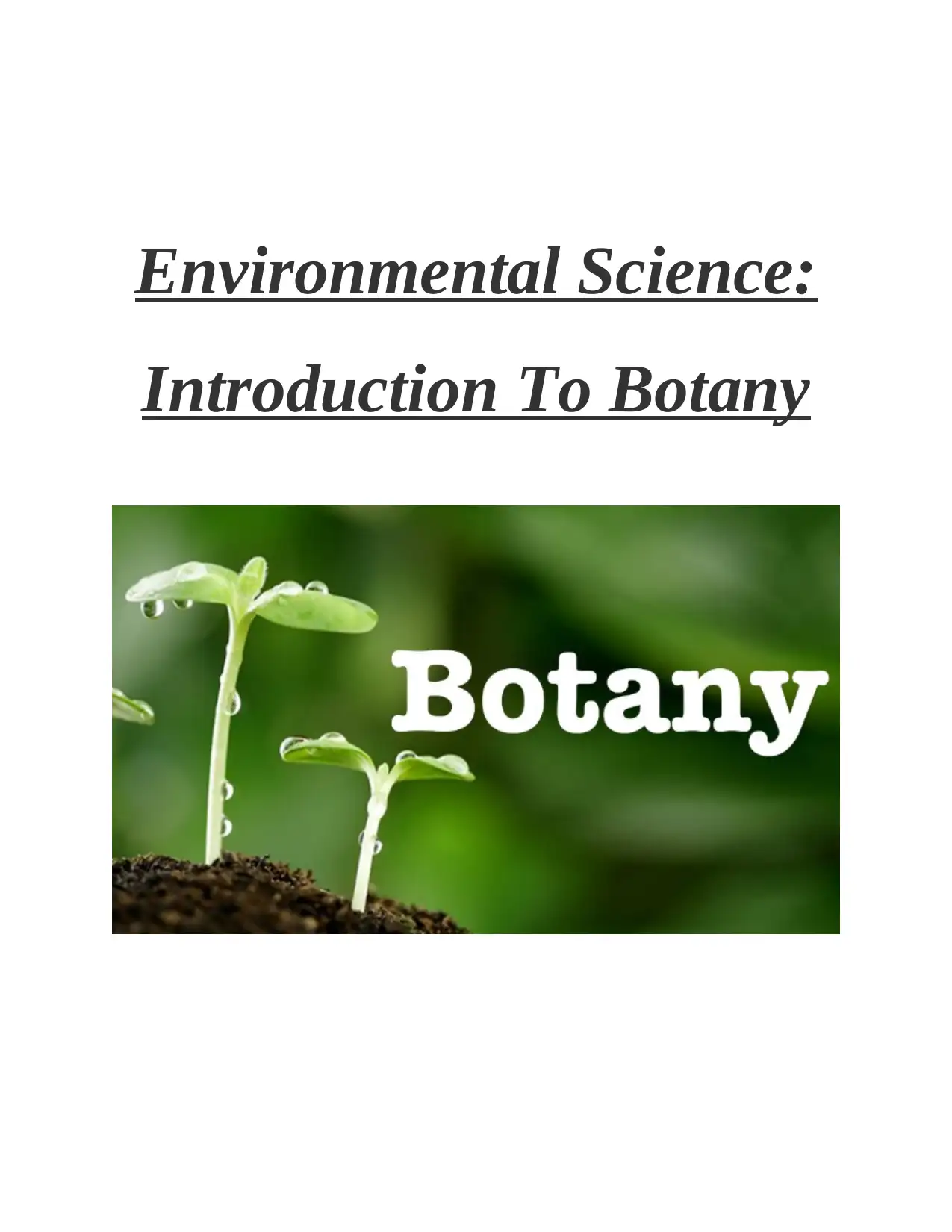
Environmental Science:
Introduction To Botany
Introduction To Botany
Paraphrase This Document
Need a fresh take? Get an instant paraphrase of this document with our AI Paraphraser
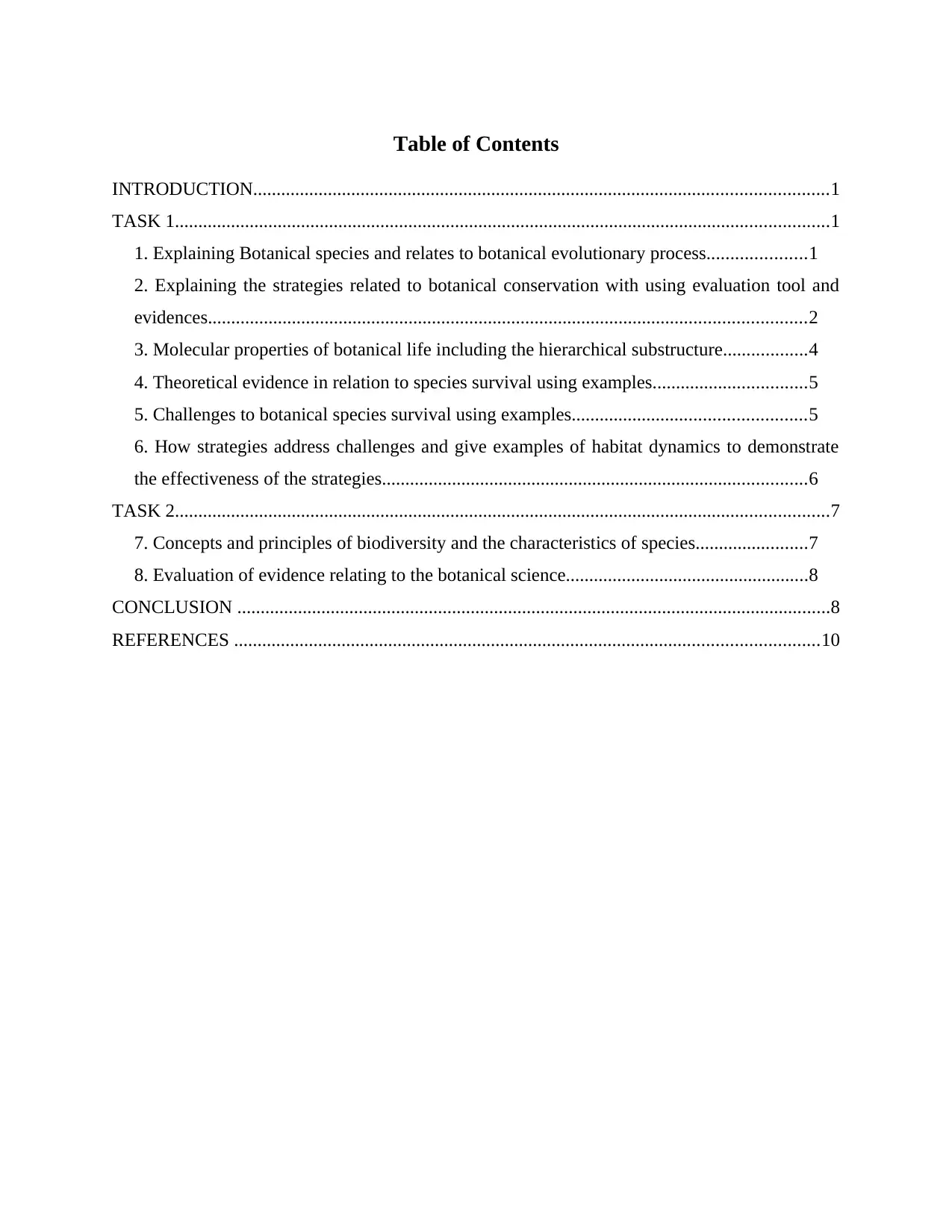
Table of Contents
INTRODUCTION...........................................................................................................................1
TASK 1............................................................................................................................................1
1. Explaining Botanical species and relates to botanical evolutionary process.....................1
2. Explaining the strategies related to botanical conservation with using evaluation tool and
evidences................................................................................................................................2
3. Molecular properties of botanical life including the hierarchical substructure..................4
4. Theoretical evidence in relation to species survival using examples.................................5
5. Challenges to botanical species survival using examples..................................................5
6. How strategies address challenges and give examples of habitat dynamics to demonstrate
the effectiveness of the strategies...........................................................................................6
TASK 2............................................................................................................................................7
7. Concepts and principles of biodiversity and the characteristics of species........................7
8. Evaluation of evidence relating to the botanical science....................................................8
CONCLUSION ...............................................................................................................................8
REFERENCES .............................................................................................................................10
INTRODUCTION...........................................................................................................................1
TASK 1............................................................................................................................................1
1. Explaining Botanical species and relates to botanical evolutionary process.....................1
2. Explaining the strategies related to botanical conservation with using evaluation tool and
evidences................................................................................................................................2
3. Molecular properties of botanical life including the hierarchical substructure..................4
4. Theoretical evidence in relation to species survival using examples.................................5
5. Challenges to botanical species survival using examples..................................................5
6. How strategies address challenges and give examples of habitat dynamics to demonstrate
the effectiveness of the strategies...........................................................................................6
TASK 2............................................................................................................................................7
7. Concepts and principles of biodiversity and the characteristics of species........................7
8. Evaluation of evidence relating to the botanical science....................................................8
CONCLUSION ...............................................................................................................................8
REFERENCES .............................................................................................................................10
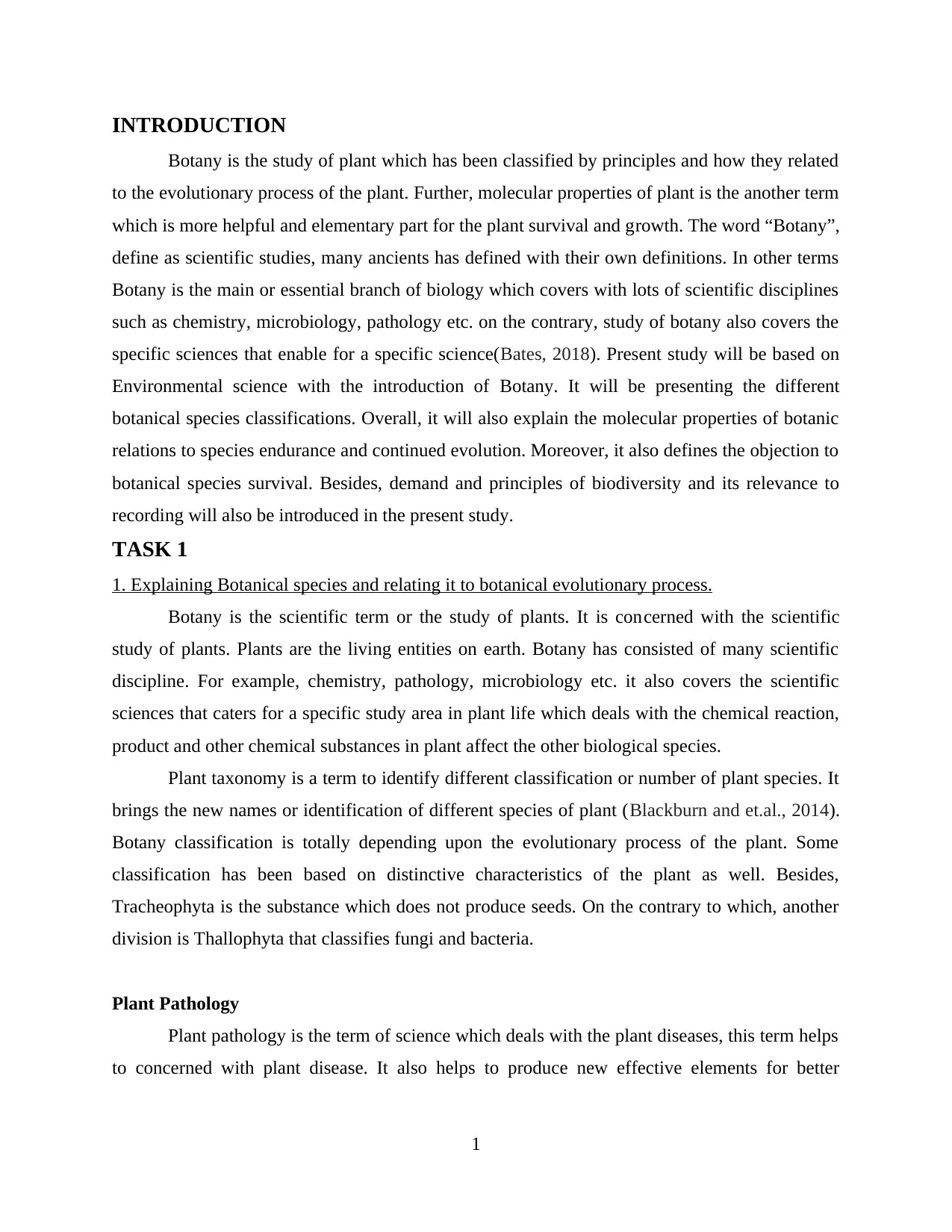
INTRODUCTION
Botany is the study of plant which has been classified by principles and how they related
to the evolutionary process of the plant. Further, molecular properties of plant is the another term
which is more helpful and elementary part for the plant survival and growth. The word “Botany”,
define as scientific studies, many ancients has defined with their own definitions. In other terms
Botany is the main or essential branch of biology which covers with lots of scientific disciplines
such as chemistry, microbiology, pathology etc. on the contrary, study of botany also covers the
specific sciences that enable for a specific science(Bates, 2018). Present study will be based on
Environmental science with the introduction of Botany. It will be presenting the different
botanical species classifications. Overall, it will also explain the molecular properties of botanic
relations to species endurance and continued evolution. Moreover, it also defines the objection to
botanical species survival. Besides, demand and principles of biodiversity and its relevance to
recording will also be introduced in the present study.
TASK 1
1. Explaining Botanical species and relating it to botanical evolutionary process.
Botany is the scientific term or the study of plants. It is concerned with the scientific
study of plants. Plants are the living entities on earth. Botany has consisted of many scientific
discipline. For example, chemistry, pathology, microbiology etc. it also covers the scientific
sciences that caters for a specific study area in plant life which deals with the chemical reaction,
product and other chemical substances in plant affect the other biological species.
Plant taxonomy is a term to identify different classification or number of plant species. It
brings the new names or identification of different species of plant (Blackburn and et.al., 2014).
Botany classification is totally depending upon the evolutionary process of the plant. Some
classification has been based on distinctive characteristics of the plant as well. Besides,
Tracheophyta is the substance which does not produce seeds. On the contrary to which, another
division is Thallophyta that classifies fungi and bacteria.
Plant Pathology
Plant pathology is the term of science which deals with the plant diseases, this term helps
to concerned with plant disease. It also helps to produce new effective elements for better
1
Botany is the study of plant which has been classified by principles and how they related
to the evolutionary process of the plant. Further, molecular properties of plant is the another term
which is more helpful and elementary part for the plant survival and growth. The word “Botany”,
define as scientific studies, many ancients has defined with their own definitions. In other terms
Botany is the main or essential branch of biology which covers with lots of scientific disciplines
such as chemistry, microbiology, pathology etc. on the contrary, study of botany also covers the
specific sciences that enable for a specific science(Bates, 2018). Present study will be based on
Environmental science with the introduction of Botany. It will be presenting the different
botanical species classifications. Overall, it will also explain the molecular properties of botanic
relations to species endurance and continued evolution. Moreover, it also defines the objection to
botanical species survival. Besides, demand and principles of biodiversity and its relevance to
recording will also be introduced in the present study.
TASK 1
1. Explaining Botanical species and relating it to botanical evolutionary process.
Botany is the scientific term or the study of plants. It is concerned with the scientific
study of plants. Plants are the living entities on earth. Botany has consisted of many scientific
discipline. For example, chemistry, pathology, microbiology etc. it also covers the scientific
sciences that caters for a specific study area in plant life which deals with the chemical reaction,
product and other chemical substances in plant affect the other biological species.
Plant taxonomy is a term to identify different classification or number of plant species. It
brings the new names or identification of different species of plant (Blackburn and et.al., 2014).
Botany classification is totally depending upon the evolutionary process of the plant. Some
classification has been based on distinctive characteristics of the plant as well. Besides,
Tracheophyta is the substance which does not produce seeds. On the contrary to which, another
division is Thallophyta that classifies fungi and bacteria.
Plant Pathology
Plant pathology is the term of science which deals with the plant diseases, this term helps
to concerned with plant disease. It also helps to produce new effective elements for better
1
⊘ This is a preview!⊘
Do you want full access?
Subscribe today to unlock all pages.

Trusted by 1+ million students worldwide
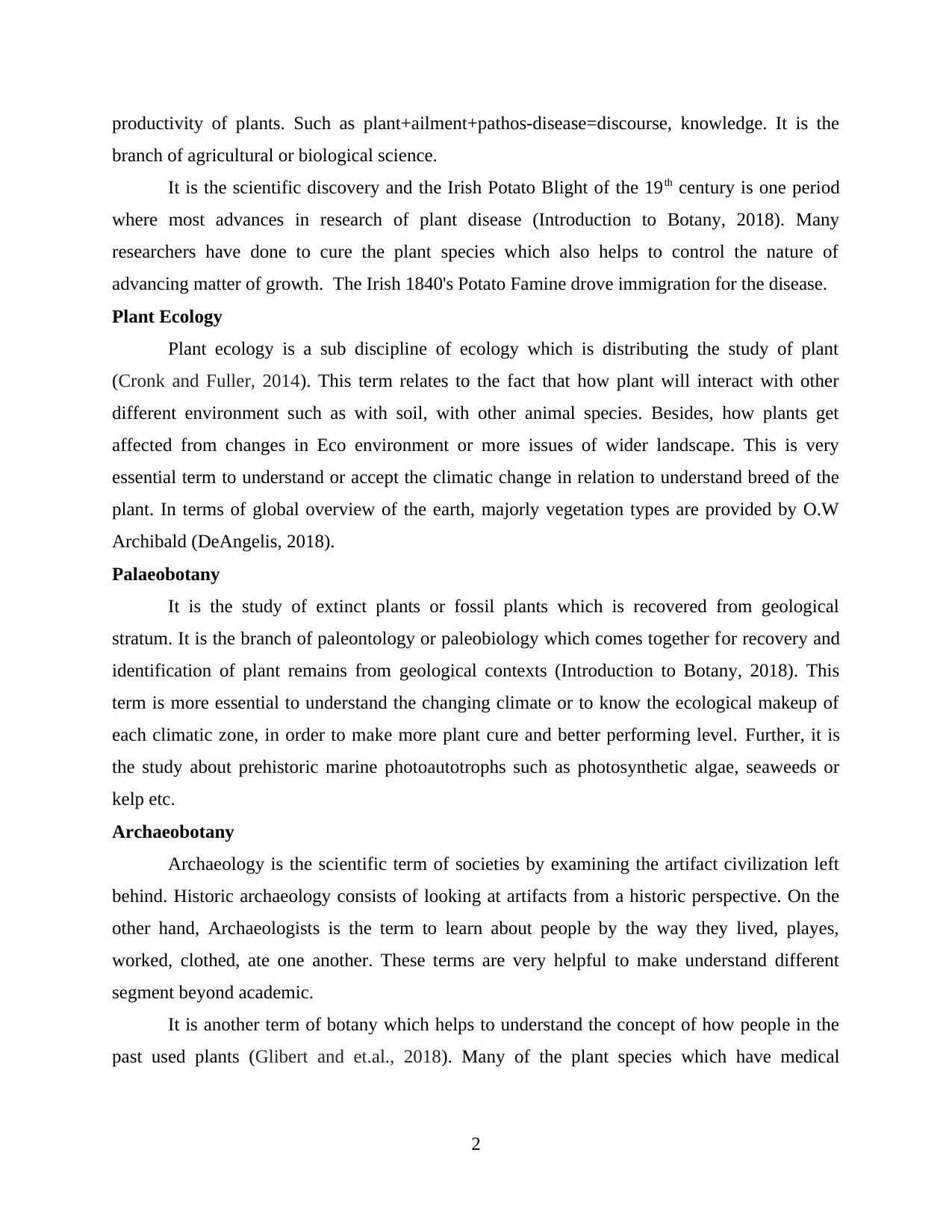
productivity of plants. Such as plant+ailment+pathos-disease=discourse, knowledge. It is the
branch of agricultural or biological science.
It is the scientific discovery and the Irish Potato Blight of the 19th century is one period
where most advances in research of plant disease (Introduction to Botany, 2018). Many
researchers have done to cure the plant species which also helps to control the nature of
advancing matter of growth. The Irish 1840's Potato Famine drove immigration for the disease.
Plant Ecology
Plant ecology is a sub discipline of ecology which is distributing the study of plant
(Cronk and Fuller, 2014). This term relates to the fact that how plant will interact with other
different environment such as with soil, with other animal species. Besides, how plants get
affected from changes in Eco environment or more issues of wider landscape. This is very
essential term to understand or accept the climatic change in relation to understand breed of the
plant. In terms of global overview of the earth, majorly vegetation types are provided by O.W
Archibald (DeAngelis, 2018).
Palaeobotany
It is the study of extinct plants or fossil plants which is recovered from geological
stratum. It is the branch of paleontology or paleobiology which comes together for recovery and
identification of plant remains from geological contexts (Introduction to Botany, 2018). This
term is more essential to understand the changing climate or to know the ecological makeup of
each climatic zone, in order to make more plant cure and better performing level. Further, it is
the study about prehistoric marine photoautotrophs such as photosynthetic algae, seaweeds or
kelp etc.
Archaeobotany
Archaeology is the scientific term of societies by examining the artifact civilization left
behind. Historic archaeology consists of looking at artifacts from a historic perspective. On the
other hand, Archaeologists is the term to learn about people by the way they lived, playes,
worked, clothed, ate one another. These terms are very helpful to make understand different
segment beyond academic.
It is another term of botany which helps to understand the concept of how people in the
past used plants (Glibert and et.al., 2018). Many of the plant species which have medical
2
branch of agricultural or biological science.
It is the scientific discovery and the Irish Potato Blight of the 19th century is one period
where most advances in research of plant disease (Introduction to Botany, 2018). Many
researchers have done to cure the plant species which also helps to control the nature of
advancing matter of growth. The Irish 1840's Potato Famine drove immigration for the disease.
Plant Ecology
Plant ecology is a sub discipline of ecology which is distributing the study of plant
(Cronk and Fuller, 2014). This term relates to the fact that how plant will interact with other
different environment such as with soil, with other animal species. Besides, how plants get
affected from changes in Eco environment or more issues of wider landscape. This is very
essential term to understand or accept the climatic change in relation to understand breed of the
plant. In terms of global overview of the earth, majorly vegetation types are provided by O.W
Archibald (DeAngelis, 2018).
Palaeobotany
It is the study of extinct plants or fossil plants which is recovered from geological
stratum. It is the branch of paleontology or paleobiology which comes together for recovery and
identification of plant remains from geological contexts (Introduction to Botany, 2018). This
term is more essential to understand the changing climate or to know the ecological makeup of
each climatic zone, in order to make more plant cure and better performing level. Further, it is
the study about prehistoric marine photoautotrophs such as photosynthetic algae, seaweeds or
kelp etc.
Archaeobotany
Archaeology is the scientific term of societies by examining the artifact civilization left
behind. Historic archaeology consists of looking at artifacts from a historic perspective. On the
other hand, Archaeologists is the term to learn about people by the way they lived, playes,
worked, clothed, ate one another. These terms are very helpful to make understand different
segment beyond academic.
It is another term of botany which helps to understand the concept of how people in the
past used plants (Glibert and et.al., 2018). Many of the plant species which have medical
2
Paraphrase This Document
Need a fresh take? Get an instant paraphrase of this document with our AI Paraphraser
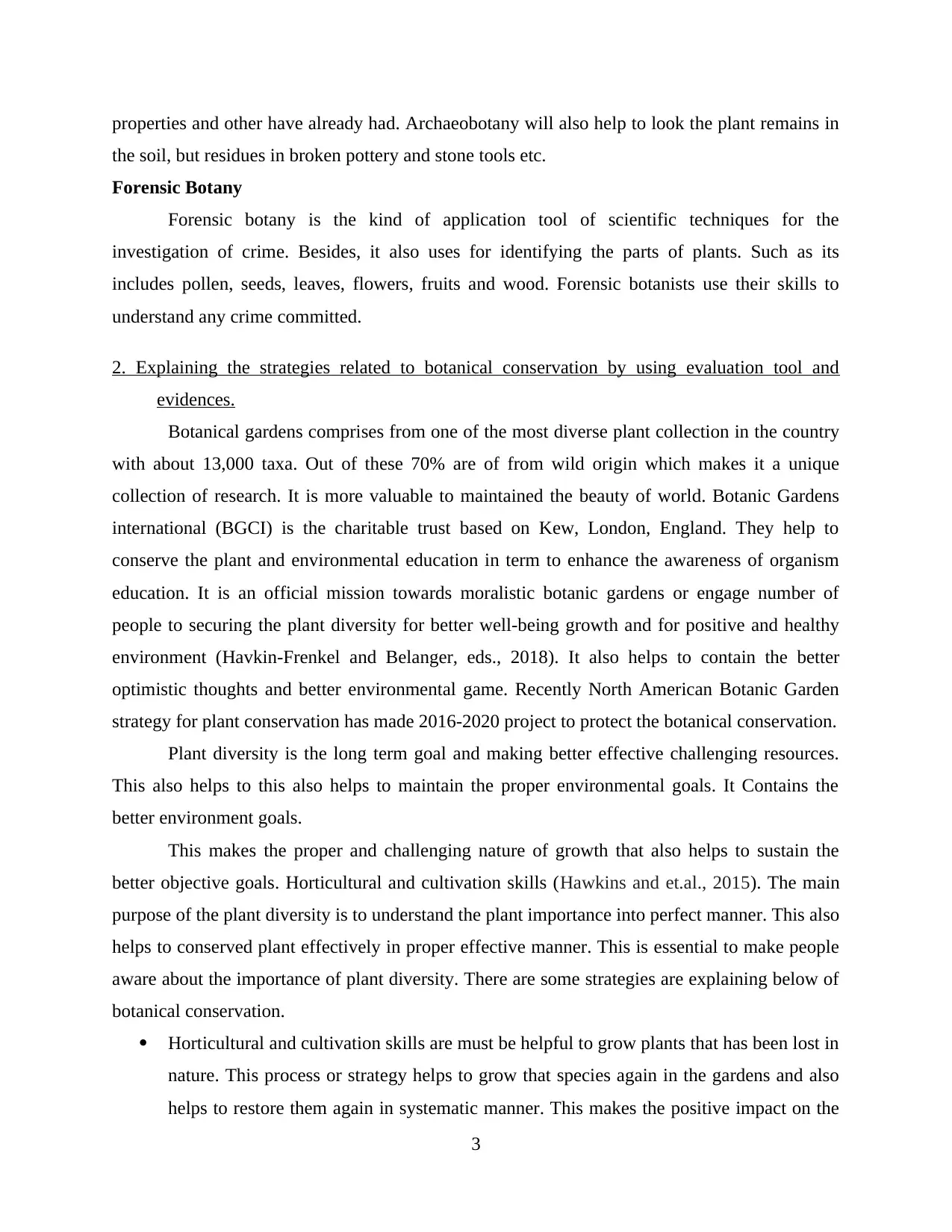
properties and other have already had. Archaeobotany will also help to look the plant remains in
the soil, but residues in broken pottery and stone tools etc.
Forensic Botany
Forensic botany is the kind of application tool of scientific techniques for the
investigation of crime. Besides, it also uses for identifying the parts of plants. Such as its
includes pollen, seeds, leaves, flowers, fruits and wood. Forensic botanists use their skills to
understand any crime committed.
2. Explaining the strategies related to botanical conservation by using evaluation tool and
evidences.
Botanical gardens comprises from one of the most diverse plant collection in the country
with about 13,000 taxa. Out of these 70% are of from wild origin which makes it a unique
collection of research. It is more valuable to maintained the beauty of world. Botanic Gardens
international (BGCI) is the charitable trust based on Kew, London, England. They help to
conserve the plant and environmental education in term to enhance the awareness of organism
education. It is an official mission towards moralistic botanic gardens or engage number of
people to securing the plant diversity for better well-being growth and for positive and healthy
environment (Havkin-Frenkel and Belanger, eds., 2018). It also helps to contain the better
optimistic thoughts and better environmental game. Recently North American Botanic Garden
strategy for plant conservation has made 2016-2020 project to protect the botanical conservation.
Plant diversity is the long term goal and making better effective challenging resources.
This also helps to this also helps to maintain the proper environmental goals. It Contains the
better environment goals.
This makes the proper and challenging nature of growth that also helps to sustain the
better objective goals. Horticultural and cultivation skills (Hawkins and et.al., 2015). The main
purpose of the plant diversity is to understand the plant importance into perfect manner. This also
helps to conserved plant effectively in proper effective manner. This is essential to make people
aware about the importance of plant diversity. There are some strategies are explaining below of
botanical conservation.
Horticultural and cultivation skills are must be helpful to grow plants that has been lost in
nature. This process or strategy helps to grow that species again in the gardens and also
helps to restore them again in systematic manner. This makes the positive impact on the
3
the soil, but residues in broken pottery and stone tools etc.
Forensic Botany
Forensic botany is the kind of application tool of scientific techniques for the
investigation of crime. Besides, it also uses for identifying the parts of plants. Such as its
includes pollen, seeds, leaves, flowers, fruits and wood. Forensic botanists use their skills to
understand any crime committed.
2. Explaining the strategies related to botanical conservation by using evaluation tool and
evidences.
Botanical gardens comprises from one of the most diverse plant collection in the country
with about 13,000 taxa. Out of these 70% are of from wild origin which makes it a unique
collection of research. It is more valuable to maintained the beauty of world. Botanic Gardens
international (BGCI) is the charitable trust based on Kew, London, England. They help to
conserve the plant and environmental education in term to enhance the awareness of organism
education. It is an official mission towards moralistic botanic gardens or engage number of
people to securing the plant diversity for better well-being growth and for positive and healthy
environment (Havkin-Frenkel and Belanger, eds., 2018). It also helps to contain the better
optimistic thoughts and better environmental game. Recently North American Botanic Garden
strategy for plant conservation has made 2016-2020 project to protect the botanical conservation.
Plant diversity is the long term goal and making better effective challenging resources.
This also helps to this also helps to maintain the proper environmental goals. It Contains the
better environment goals.
This makes the proper and challenging nature of growth that also helps to sustain the
better objective goals. Horticultural and cultivation skills (Hawkins and et.al., 2015). The main
purpose of the plant diversity is to understand the plant importance into perfect manner. This also
helps to conserved plant effectively in proper effective manner. This is essential to make people
aware about the importance of plant diversity. There are some strategies are explaining below of
botanical conservation.
Horticultural and cultivation skills are must be helpful to grow plants that has been lost in
nature. This process or strategy helps to grow that species again in the gardens and also
helps to restore them again in systematic manner. This makes the positive impact on the
3
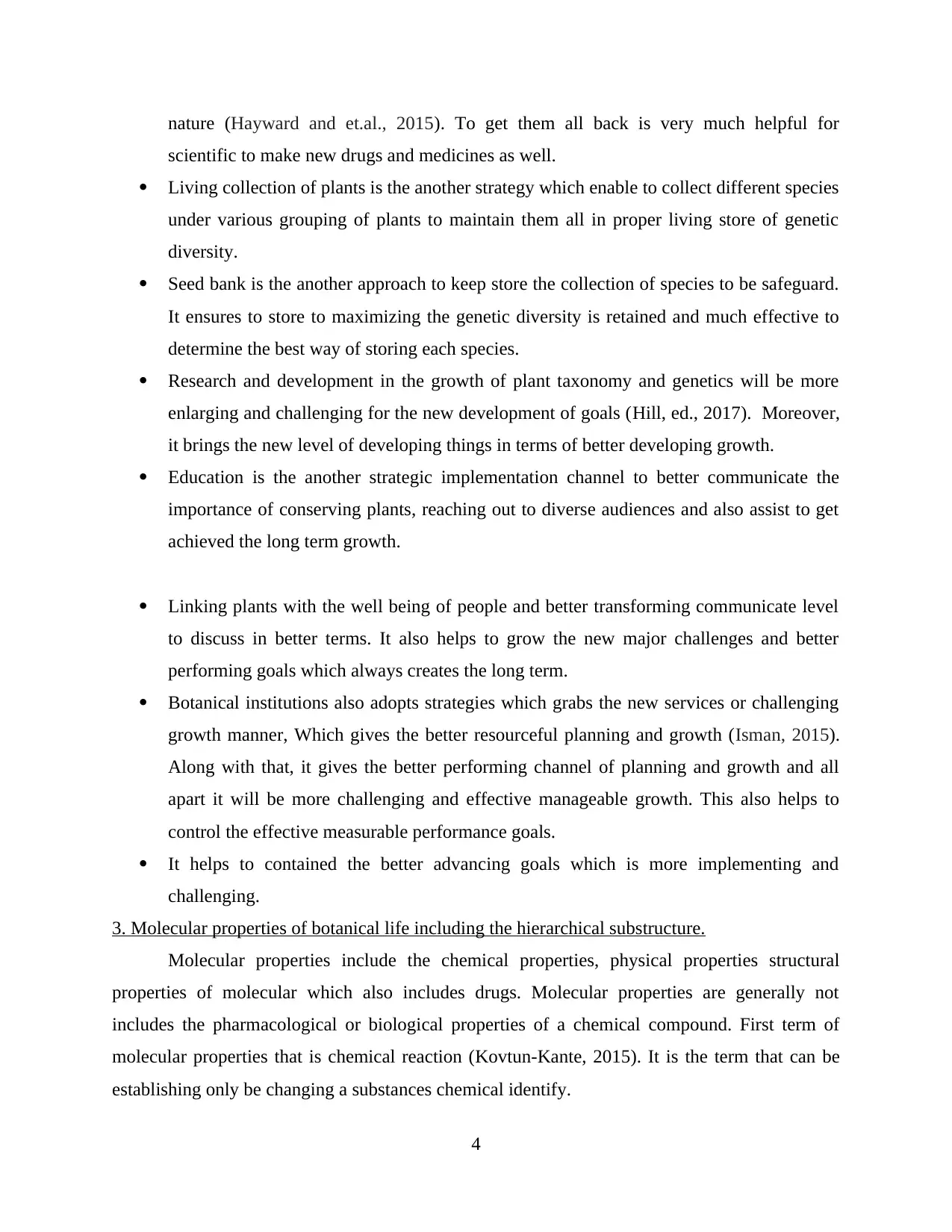
nature (Hayward and et.al., 2015). To get them all back is very much helpful for
scientific to make new drugs and medicines as well.
Living collection of plants is the another strategy which enable to collect different species
under various grouping of plants to maintain them all in proper living store of genetic
diversity.
Seed bank is the another approach to keep store the collection of species to be safeguard.
It ensures to store to maximizing the genetic diversity is retained and much effective to
determine the best way of storing each species.
Research and development in the growth of plant taxonomy and genetics will be more
enlarging and challenging for the new development of goals (Hill, ed., 2017). Moreover,
it brings the new level of developing things in terms of better developing growth.
Education is the another strategic implementation channel to better communicate the
importance of conserving plants, reaching out to diverse audiences and also assist to get
achieved the long term growth.
Linking plants with the well being of people and better transforming communicate level
to discuss in better terms. It also helps to grow the new major challenges and better
performing goals which always creates the long term.
Botanical institutions also adopts strategies which grabs the new services or challenging
growth manner, Which gives the better resourceful planning and growth (Isman, 2015).
Along with that, it gives the better performing channel of planning and growth and all
apart it will be more challenging and effective manageable growth. This also helps to
control the effective measurable performance goals.
It helps to contained the better advancing goals which is more implementing and
challenging.
3. Molecular properties of botanical life including the hierarchical substructure.
Molecular properties include the chemical properties, physical properties structural
properties of molecular which also includes drugs. Molecular properties are generally not
includes the pharmacological or biological properties of a chemical compound. First term of
molecular properties that is chemical reaction (Kovtun-Kante, 2015). It is the term that can be
establishing only be changing a substances chemical identify.
4
scientific to make new drugs and medicines as well.
Living collection of plants is the another strategy which enable to collect different species
under various grouping of plants to maintain them all in proper living store of genetic
diversity.
Seed bank is the another approach to keep store the collection of species to be safeguard.
It ensures to store to maximizing the genetic diversity is retained and much effective to
determine the best way of storing each species.
Research and development in the growth of plant taxonomy and genetics will be more
enlarging and challenging for the new development of goals (Hill, ed., 2017). Moreover,
it brings the new level of developing things in terms of better developing growth.
Education is the another strategic implementation channel to better communicate the
importance of conserving plants, reaching out to diverse audiences and also assist to get
achieved the long term growth.
Linking plants with the well being of people and better transforming communicate level
to discuss in better terms. It also helps to grow the new major challenges and better
performing goals which always creates the long term.
Botanical institutions also adopts strategies which grabs the new services or challenging
growth manner, Which gives the better resourceful planning and growth (Isman, 2015).
Along with that, it gives the better performing channel of planning and growth and all
apart it will be more challenging and effective manageable growth. This also helps to
control the effective measurable performance goals.
It helps to contained the better advancing goals which is more implementing and
challenging.
3. Molecular properties of botanical life including the hierarchical substructure.
Molecular properties include the chemical properties, physical properties structural
properties of molecular which also includes drugs. Molecular properties are generally not
includes the pharmacological or biological properties of a chemical compound. First term of
molecular properties that is chemical reaction (Kovtun-Kante, 2015). It is the term that can be
establishing only be changing a substances chemical identify.
4
⊘ This is a preview!⊘
Do you want full access?
Subscribe today to unlock all pages.

Trusted by 1+ million students worldwide
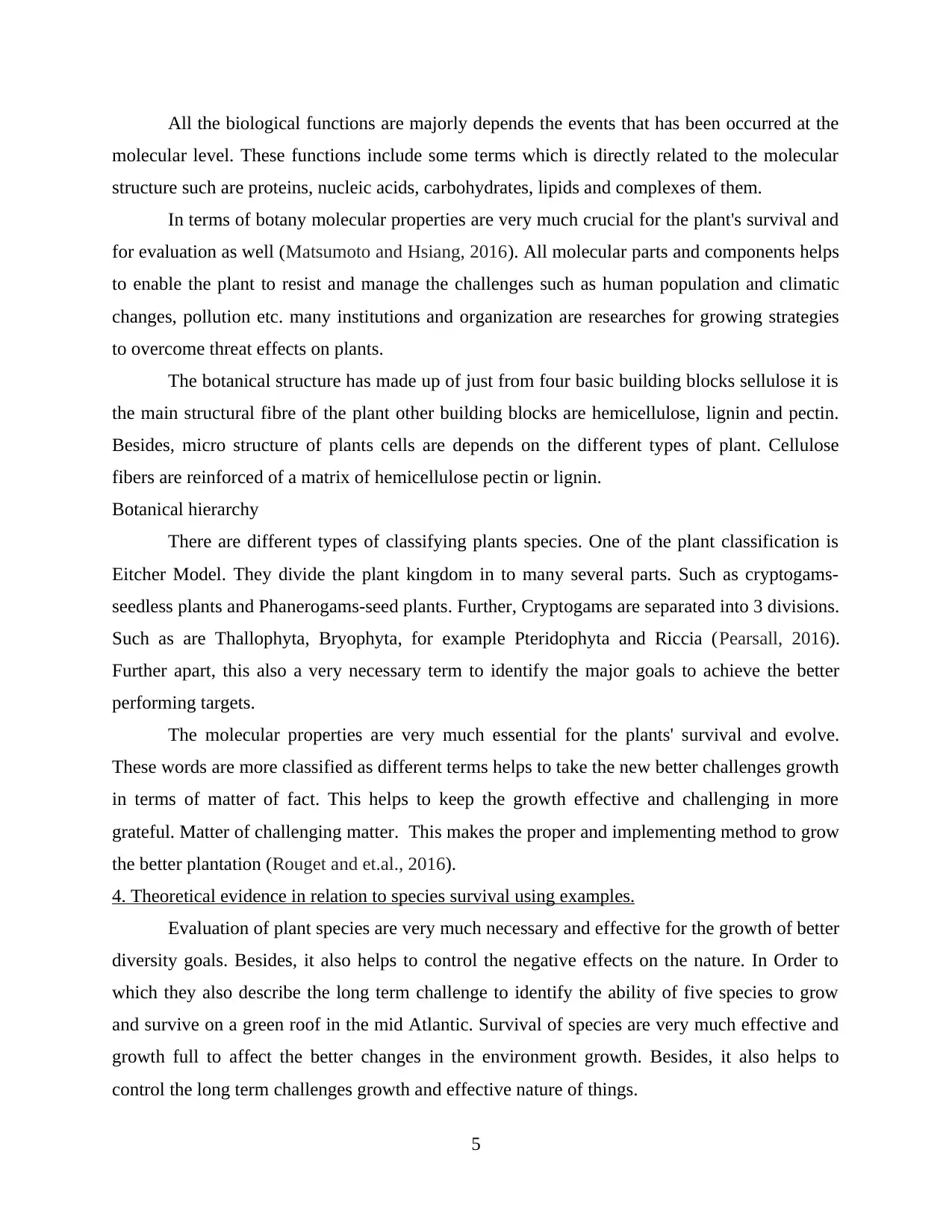
All the biological functions are majorly depends the events that has been occurred at the
molecular level. These functions include some terms which is directly related to the molecular
structure such are proteins, nucleic acids, carbohydrates, lipids and complexes of them.
In terms of botany molecular properties are very much crucial for the plant's survival and
for evaluation as well (Matsumoto and Hsiang, 2016). All molecular parts and components helps
to enable the plant to resist and manage the challenges such as human population and climatic
changes, pollution etc. many institutions and organization are researches for growing strategies
to overcome threat effects on plants.
The botanical structure has made up of just from four basic building blocks sellulose it is
the main structural fibre of the plant other building blocks are hemicellulose, lignin and pectin.
Besides, micro structure of plants cells are depends on the different types of plant. Cellulose
fibers are reinforced of a matrix of hemicellulose pectin or lignin.
Botanical hierarchy
There are different types of classifying plants species. One of the plant classification is
Eitcher Model. They divide the plant kingdom in to many several parts. Such as cryptogams-
seedless plants and Phanerogams-seed plants. Further, Cryptogams are separated into 3 divisions.
Such as are Thallophyta, Bryophyta, for example Pteridophyta and Riccia (Pearsall, 2016).
Further apart, this also a very necessary term to identify the major goals to achieve the better
performing targets.
The molecular properties are very much essential for the plants' survival and evolve.
These words are more classified as different terms helps to take the new better challenges growth
in terms of matter of fact. This helps to keep the growth effective and challenging in more
grateful. Matter of challenging matter. This makes the proper and implementing method to grow
the better plantation (Rouget and et.al., 2016).
4. Theoretical evidence in relation to species survival using examples.
Evaluation of plant species are very much necessary and effective for the growth of better
diversity goals. Besides, it also helps to control the negative effects on the nature. In Order to
which they also describe the long term challenge to identify the ability of five species to grow
and survive on a green roof in the mid Atlantic. Survival of species are very much effective and
growth full to affect the better changes in the environment growth. Besides, it also helps to
control the long term challenges growth and effective nature of things.
5
molecular level. These functions include some terms which is directly related to the molecular
structure such are proteins, nucleic acids, carbohydrates, lipids and complexes of them.
In terms of botany molecular properties are very much crucial for the plant's survival and
for evaluation as well (Matsumoto and Hsiang, 2016). All molecular parts and components helps
to enable the plant to resist and manage the challenges such as human population and climatic
changes, pollution etc. many institutions and organization are researches for growing strategies
to overcome threat effects on plants.
The botanical structure has made up of just from four basic building blocks sellulose it is
the main structural fibre of the plant other building blocks are hemicellulose, lignin and pectin.
Besides, micro structure of plants cells are depends on the different types of plant. Cellulose
fibers are reinforced of a matrix of hemicellulose pectin or lignin.
Botanical hierarchy
There are different types of classifying plants species. One of the plant classification is
Eitcher Model. They divide the plant kingdom in to many several parts. Such as cryptogams-
seedless plants and Phanerogams-seed plants. Further, Cryptogams are separated into 3 divisions.
Such as are Thallophyta, Bryophyta, for example Pteridophyta and Riccia (Pearsall, 2016).
Further apart, this also a very necessary term to identify the major goals to achieve the better
performing targets.
The molecular properties are very much essential for the plants' survival and evolve.
These words are more classified as different terms helps to take the new better challenges growth
in terms of matter of fact. This helps to keep the growth effective and challenging in more
grateful. Matter of challenging matter. This makes the proper and implementing method to grow
the better plantation (Rouget and et.al., 2016).
4. Theoretical evidence in relation to species survival using examples.
Evaluation of plant species are very much necessary and effective for the growth of better
diversity goals. Besides, it also helps to control the negative effects on the nature. In Order to
which they also describe the long term challenge to identify the ability of five species to grow
and survive on a green roof in the mid Atlantic. Survival of species are very much effective and
growth full to affect the better changes in the environment growth. Besides, it also helps to
control the long term challenges growth and effective nature of things.
5
Paraphrase This Document
Need a fresh take? Get an instant paraphrase of this document with our AI Paraphraser
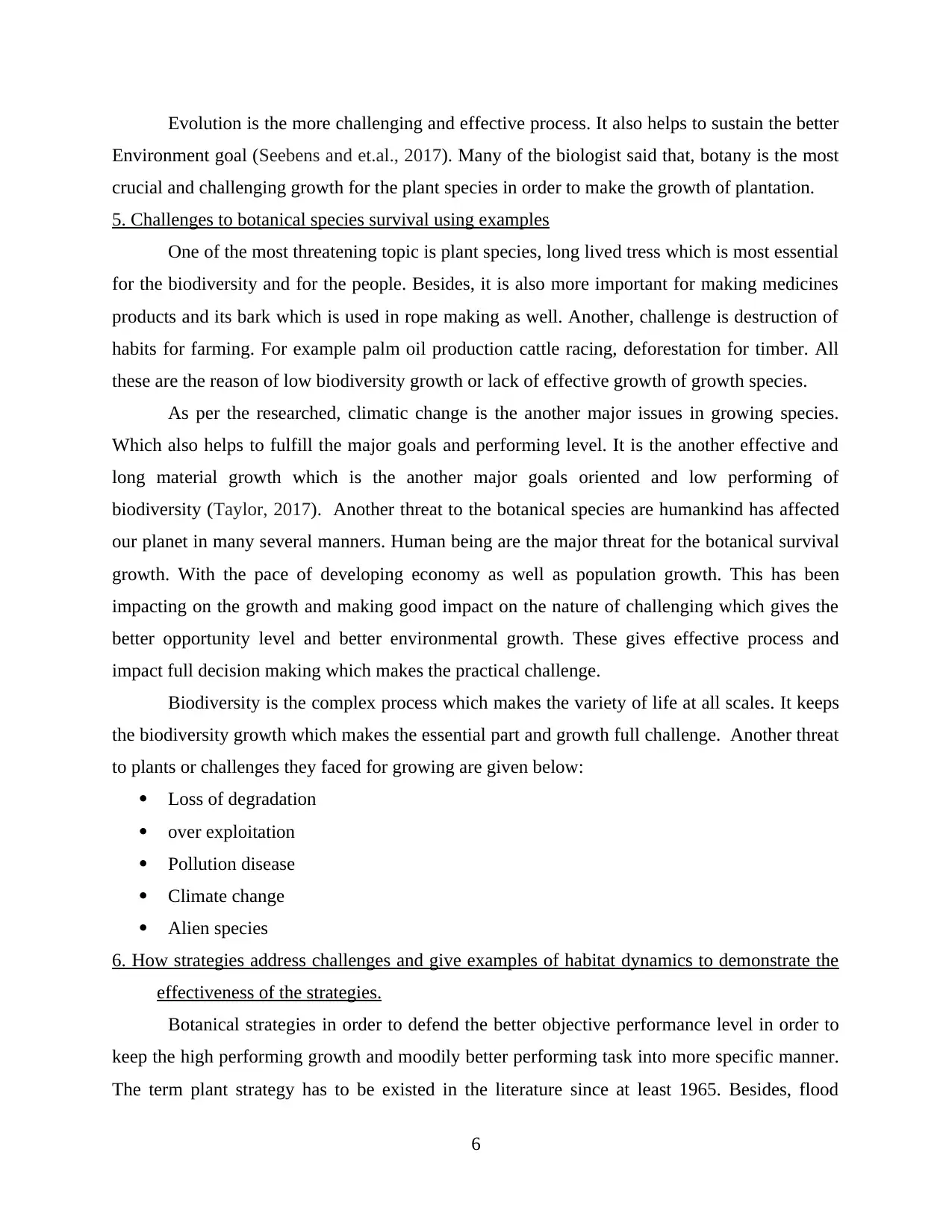
Evolution is the more challenging and effective process. It also helps to sustain the better
Environment goal (Seebens and et.al., 2017). Many of the biologist said that, botany is the most
crucial and challenging growth for the plant species in order to make the growth of plantation.
5. Challenges to botanical species survival using examples
One of the most threatening topic is plant species, long lived tress which is most essential
for the biodiversity and for the people. Besides, it is also more important for making medicines
products and its bark which is used in rope making as well. Another, challenge is destruction of
habits for farming. For example palm oil production cattle racing, deforestation for timber. All
these are the reason of low biodiversity growth or lack of effective growth of growth species.
As per the researched, climatic change is the another major issues in growing species.
Which also helps to fulfill the major goals and performing level. It is the another effective and
long material growth which is the another major goals oriented and low performing of
biodiversity (Taylor, 2017). Another threat to the botanical species are humankind has affected
our planet in many several manners. Human being are the major threat for the botanical survival
growth. With the pace of developing economy as well as population growth. This has been
impacting on the growth and making good impact on the nature of challenging which gives the
better opportunity level and better environmental growth. These gives effective process and
impact full decision making which makes the practical challenge.
Biodiversity is the complex process which makes the variety of life at all scales. It keeps
the biodiversity growth which makes the essential part and growth full challenge. Another threat
to plants or challenges they faced for growing are given below:
Loss of degradation
over exploitation
Pollution disease
Climate change
Alien species
6. How strategies address challenges and give examples of habitat dynamics to demonstrate the
effectiveness of the strategies.
Botanical strategies in order to defend the better objective performance level in order to
keep the high performing growth and moodily better performing task into more specific manner.
The term plant strategy has to be existed in the literature since at least 1965. Besides, flood
6
Environment goal (Seebens and et.al., 2017). Many of the biologist said that, botany is the most
crucial and challenging growth for the plant species in order to make the growth of plantation.
5. Challenges to botanical species survival using examples
One of the most threatening topic is plant species, long lived tress which is most essential
for the biodiversity and for the people. Besides, it is also more important for making medicines
products and its bark which is used in rope making as well. Another, challenge is destruction of
habits for farming. For example palm oil production cattle racing, deforestation for timber. All
these are the reason of low biodiversity growth or lack of effective growth of growth species.
As per the researched, climatic change is the another major issues in growing species.
Which also helps to fulfill the major goals and performing level. It is the another effective and
long material growth which is the another major goals oriented and low performing of
biodiversity (Taylor, 2017). Another threat to the botanical species are humankind has affected
our planet in many several manners. Human being are the major threat for the botanical survival
growth. With the pace of developing economy as well as population growth. This has been
impacting on the growth and making good impact on the nature of challenging which gives the
better opportunity level and better environmental growth. These gives effective process and
impact full decision making which makes the practical challenge.
Biodiversity is the complex process which makes the variety of life at all scales. It keeps
the biodiversity growth which makes the essential part and growth full challenge. Another threat
to plants or challenges they faced for growing are given below:
Loss of degradation
over exploitation
Pollution disease
Climate change
Alien species
6. How strategies address challenges and give examples of habitat dynamics to demonstrate the
effectiveness of the strategies.
Botanical strategies in order to defend the better objective performance level in order to
keep the high performing growth and moodily better performing task into more specific manner.
The term plant strategy has to be existed in the literature since at least 1965. Besides, flood
6
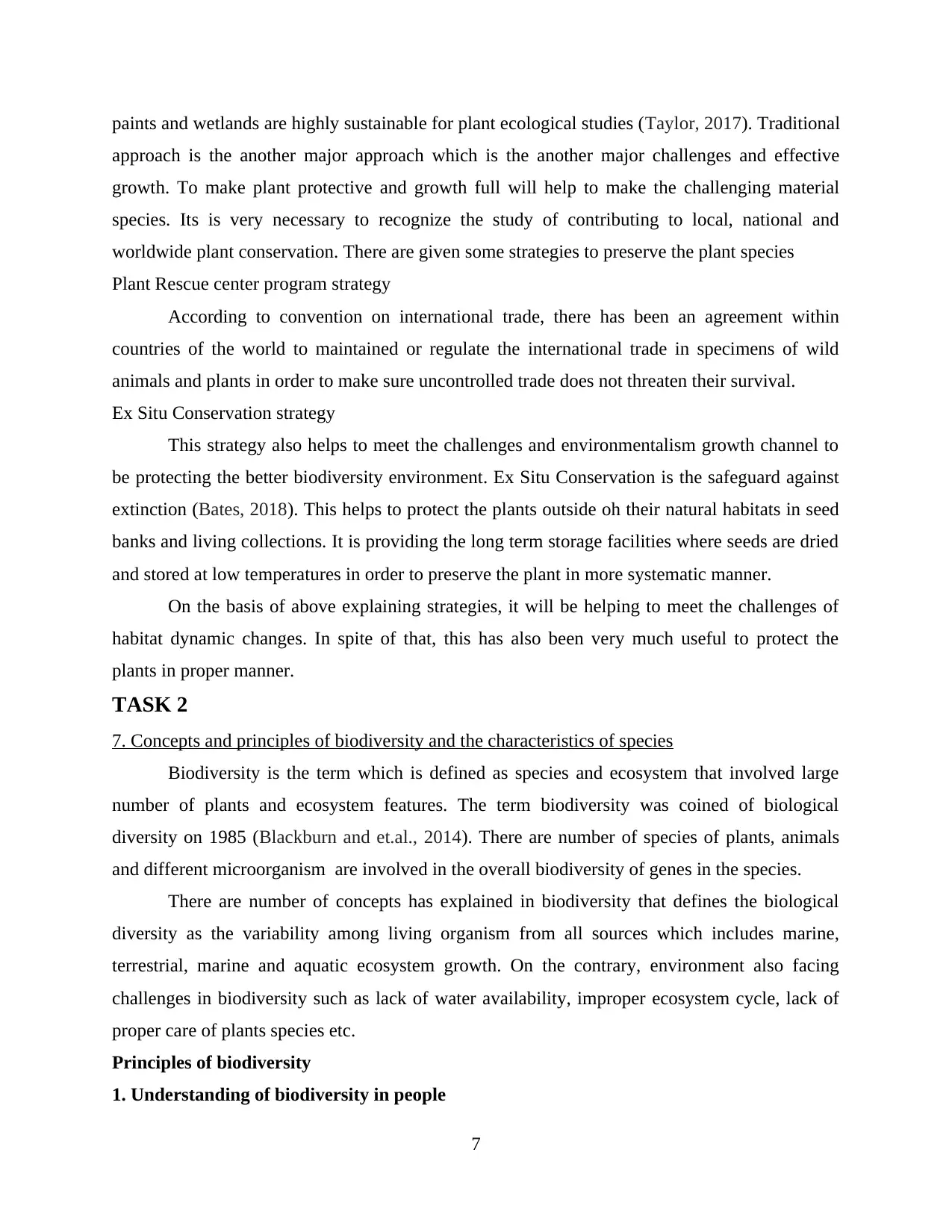
paints and wetlands are highly sustainable for plant ecological studies (Taylor, 2017). Traditional
approach is the another major approach which is the another major challenges and effective
growth. To make plant protective and growth full will help to make the challenging material
species. Its is very necessary to recognize the study of contributing to local, national and
worldwide plant conservation. There are given some strategies to preserve the plant species
Plant Rescue center program strategy
According to convention on international trade, there has been an agreement within
countries of the world to maintained or regulate the international trade in specimens of wild
animals and plants in order to make sure uncontrolled trade does not threaten their survival.
Ex Situ Conservation strategy
This strategy also helps to meet the challenges and environmentalism growth channel to
be protecting the better biodiversity environment. Ex Situ Conservation is the safeguard against
extinction (Bates, 2018). This helps to protect the plants outside oh their natural habitats in seed
banks and living collections. It is providing the long term storage facilities where seeds are dried
and stored at low temperatures in order to preserve the plant in more systematic manner.
On the basis of above explaining strategies, it will be helping to meet the challenges of
habitat dynamic changes. In spite of that, this has also been very much useful to protect the
plants in proper manner.
TASK 2
7. Concepts and principles of biodiversity and the characteristics of species
Biodiversity is the term which is defined as species and ecosystem that involved large
number of plants and ecosystem features. The term biodiversity was coined of biological
diversity on 1985 (Blackburn and et.al., 2014). There are number of species of plants, animals
and different microorganism are involved in the overall biodiversity of genes in the species.
There are number of concepts has explained in biodiversity that defines the biological
diversity as the variability among living organism from all sources which includes marine,
terrestrial, marine and aquatic ecosystem growth. On the contrary, environment also facing
challenges in biodiversity such as lack of water availability, improper ecosystem cycle, lack of
proper care of plants species etc.
Principles of biodiversity
1. Understanding of biodiversity in people
7
approach is the another major approach which is the another major challenges and effective
growth. To make plant protective and growth full will help to make the challenging material
species. Its is very necessary to recognize the study of contributing to local, national and
worldwide plant conservation. There are given some strategies to preserve the plant species
Plant Rescue center program strategy
According to convention on international trade, there has been an agreement within
countries of the world to maintained or regulate the international trade in specimens of wild
animals and plants in order to make sure uncontrolled trade does not threaten their survival.
Ex Situ Conservation strategy
This strategy also helps to meet the challenges and environmentalism growth channel to
be protecting the better biodiversity environment. Ex Situ Conservation is the safeguard against
extinction (Bates, 2018). This helps to protect the plants outside oh their natural habitats in seed
banks and living collections. It is providing the long term storage facilities where seeds are dried
and stored at low temperatures in order to preserve the plant in more systematic manner.
On the basis of above explaining strategies, it will be helping to meet the challenges of
habitat dynamic changes. In spite of that, this has also been very much useful to protect the
plants in proper manner.
TASK 2
7. Concepts and principles of biodiversity and the characteristics of species
Biodiversity is the term which is defined as species and ecosystem that involved large
number of plants and ecosystem features. The term biodiversity was coined of biological
diversity on 1985 (Blackburn and et.al., 2014). There are number of species of plants, animals
and different microorganism are involved in the overall biodiversity of genes in the species.
There are number of concepts has explained in biodiversity that defines the biological
diversity as the variability among living organism from all sources which includes marine,
terrestrial, marine and aquatic ecosystem growth. On the contrary, environment also facing
challenges in biodiversity such as lack of water availability, improper ecosystem cycle, lack of
proper care of plants species etc.
Principles of biodiversity
1. Understanding of biodiversity in people
7
⊘ This is a preview!⊘
Do you want full access?
Subscribe today to unlock all pages.

Trusted by 1+ million students worldwide
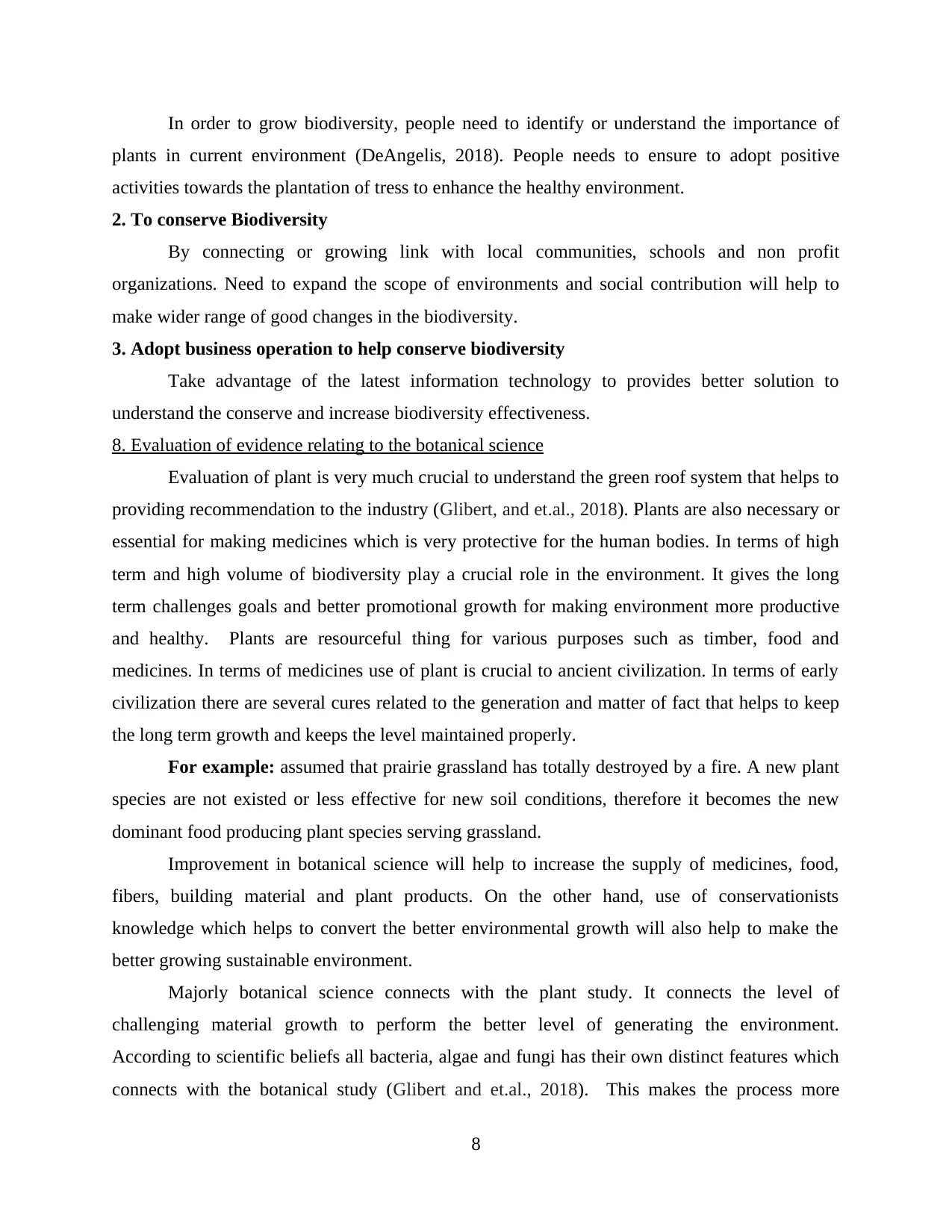
In order to grow biodiversity, people need to identify or understand the importance of
plants in current environment (DeAngelis, 2018). People needs to ensure to adopt positive
activities towards the plantation of tress to enhance the healthy environment.
2. To conserve Biodiversity
By connecting or growing link with local communities, schools and non profit
organizations. Need to expand the scope of environments and social contribution will help to
make wider range of good changes in the biodiversity.
3. Adopt business operation to help conserve biodiversity
Take advantage of the latest information technology to provides better solution to
understand the conserve and increase biodiversity effectiveness.
8. Evaluation of evidence relating to the botanical science
Evaluation of plant is very much crucial to understand the green roof system that helps to
providing recommendation to the industry (Glibert, and et.al., 2018). Plants are also necessary or
essential for making medicines which is very protective for the human bodies. In terms of high
term and high volume of biodiversity play a crucial role in the environment. It gives the long
term challenges goals and better promotional growth for making environment more productive
and healthy. Plants are resourceful thing for various purposes such as timber, food and
medicines. In terms of medicines use of plant is crucial to ancient civilization. In terms of early
civilization there are several cures related to the generation and matter of fact that helps to keep
the long term growth and keeps the level maintained properly.
For example: assumed that prairie grassland has totally destroyed by a fire. A new plant
species are not existed or less effective for new soil conditions, therefore it becomes the new
dominant food producing plant species serving grassland.
Improvement in botanical science will help to increase the supply of medicines, food,
fibers, building material and plant products. On the other hand, use of conservationists
knowledge which helps to convert the better environmental growth will also help to make the
better growing sustainable environment.
Majorly botanical science connects with the plant study. It connects the level of
challenging material growth to perform the better level of generating the environment.
According to scientific beliefs all bacteria, algae and fungi has their own distinct features which
connects with the botanical study (Glibert and et.al., 2018). This makes the process more
8
plants in current environment (DeAngelis, 2018). People needs to ensure to adopt positive
activities towards the plantation of tress to enhance the healthy environment.
2. To conserve Biodiversity
By connecting or growing link with local communities, schools and non profit
organizations. Need to expand the scope of environments and social contribution will help to
make wider range of good changes in the biodiversity.
3. Adopt business operation to help conserve biodiversity
Take advantage of the latest information technology to provides better solution to
understand the conserve and increase biodiversity effectiveness.
8. Evaluation of evidence relating to the botanical science
Evaluation of plant is very much crucial to understand the green roof system that helps to
providing recommendation to the industry (Glibert, and et.al., 2018). Plants are also necessary or
essential for making medicines which is very protective for the human bodies. In terms of high
term and high volume of biodiversity play a crucial role in the environment. It gives the long
term challenges goals and better promotional growth for making environment more productive
and healthy. Plants are resourceful thing for various purposes such as timber, food and
medicines. In terms of medicines use of plant is crucial to ancient civilization. In terms of early
civilization there are several cures related to the generation and matter of fact that helps to keep
the long term growth and keeps the level maintained properly.
For example: assumed that prairie grassland has totally destroyed by a fire. A new plant
species are not existed or less effective for new soil conditions, therefore it becomes the new
dominant food producing plant species serving grassland.
Improvement in botanical science will help to increase the supply of medicines, food,
fibers, building material and plant products. On the other hand, use of conservationists
knowledge which helps to convert the better environmental growth will also help to make the
better growing sustainable environment.
Majorly botanical science connects with the plant study. It connects the level of
challenging material growth to perform the better level of generating the environment.
According to scientific beliefs all bacteria, algae and fungi has their own distinct features which
connects with the botanical study (Glibert and et.al., 2018). This makes the process more
8
Paraphrase This Document
Need a fresh take? Get an instant paraphrase of this document with our AI Paraphraser
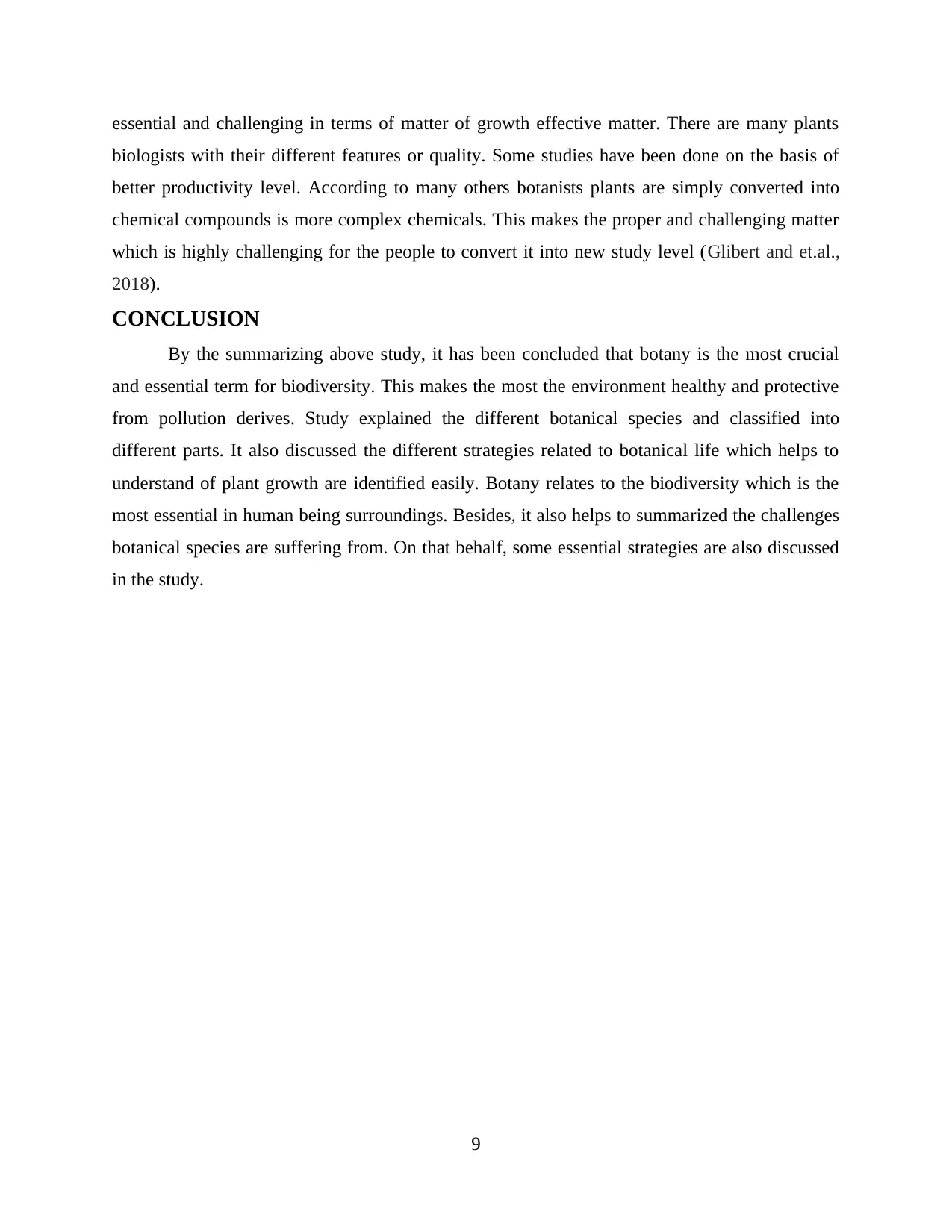
essential and challenging in terms of matter of growth effective matter. There are many plants
biologists with their different features or quality. Some studies have been done on the basis of
better productivity level. According to many others botanists plants are simply converted into
chemical compounds is more complex chemicals. This makes the proper and challenging matter
which is highly challenging for the people to convert it into new study level (Glibert and et.al.,
2018).
CONCLUSION
By the summarizing above study, it has been concluded that botany is the most crucial
and essential term for biodiversity. This makes the most the environment healthy and protective
from pollution derives. Study explained the different botanical species and classified into
different parts. It also discussed the different strategies related to botanical life which helps to
understand of plant growth are identified easily. Botany relates to the biodiversity which is the
most essential in human being surroundings. Besides, it also helps to summarized the challenges
botanical species are suffering from. On that behalf, some essential strategies are also discussed
in the study.
9
biologists with their different features or quality. Some studies have been done on the basis of
better productivity level. According to many others botanists plants are simply converted into
chemical compounds is more complex chemicals. This makes the proper and challenging matter
which is highly challenging for the people to convert it into new study level (Glibert and et.al.,
2018).
CONCLUSION
By the summarizing above study, it has been concluded that botany is the most crucial
and essential term for biodiversity. This makes the most the environment healthy and protective
from pollution derives. Study explained the different botanical species and classified into
different parts. It also discussed the different strategies related to botanical life which helps to
understand of plant growth are identified easily. Botany relates to the biodiversity which is the
most essential in human being surroundings. Besides, it also helps to summarized the challenges
botanical species are suffering from. On that behalf, some essential strategies are also discussed
in the study.
9
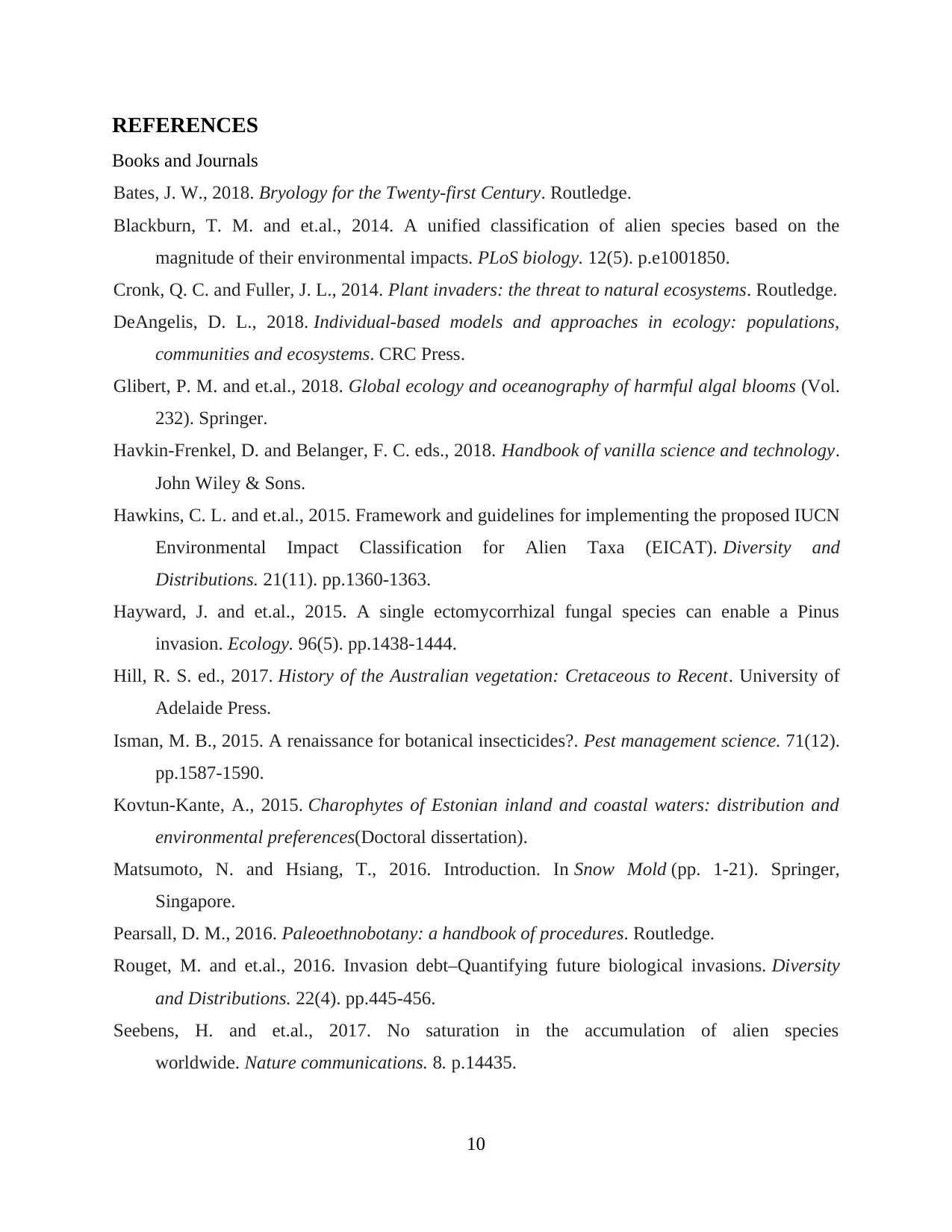
REFERENCES
Books and Journals
Bates, J. W., 2018. Bryology for the Twenty-first Century. Routledge.
Blackburn, T. M. and et.al., 2014. A unified classification of alien species based on the
magnitude of their environmental impacts. PLoS biology. 12(5). p.e1001850.
Cronk, Q. C. and Fuller, J. L., 2014. Plant invaders: the threat to natural ecosystems. Routledge.
DeAngelis, D. L., 2018. Individual-based models and approaches in ecology: populations,
communities and ecosystems. CRC Press.
Glibert, P. M. and et.al., 2018. Global ecology and oceanography of harmful algal blooms (Vol.
232). Springer.
Havkin-Frenkel, D. and Belanger, F. C. eds., 2018. Handbook of vanilla science and technology.
John Wiley & Sons.
Hawkins, C. L. and et.al., 2015. Framework and guidelines for implementing the proposed IUCN
Environmental Impact Classification for Alien Taxa (EICAT). Diversity and
Distributions. 21(11). pp.1360-1363.
Hayward, J. and et.al., 2015. A single ectomycorrhizal fungal species can enable a Pinus
invasion. Ecology. 96(5). pp.1438-1444.
Hill, R. S. ed., 2017. History of the Australian vegetation: Cretaceous to Recent. University of
Adelaide Press.
Isman, M. B., 2015. A renaissance for botanical insecticides?. Pest management science. 71(12).
pp.1587-1590.
Kovtun-Kante, A., 2015. Charophytes of Estonian inland and coastal waters: distribution and
environmental preferences(Doctoral dissertation).
Matsumoto, N. and Hsiang, T., 2016. Introduction. In Snow Mold (pp. 1-21). Springer,
Singapore.
Pearsall, D. M., 2016. Paleoethnobotany: a handbook of procedures. Routledge.
Rouget, M. and et.al., 2016. Invasion debt–Quantifying future biological invasions. Diversity
and Distributions. 22(4). pp.445-456.
Seebens, H. and et.al., 2017. No saturation in the accumulation of alien species
worldwide. Nature communications. 8. p.14435.
10
Books and Journals
Bates, J. W., 2018. Bryology for the Twenty-first Century. Routledge.
Blackburn, T. M. and et.al., 2014. A unified classification of alien species based on the
magnitude of their environmental impacts. PLoS biology. 12(5). p.e1001850.
Cronk, Q. C. and Fuller, J. L., 2014. Plant invaders: the threat to natural ecosystems. Routledge.
DeAngelis, D. L., 2018. Individual-based models and approaches in ecology: populations,
communities and ecosystems. CRC Press.
Glibert, P. M. and et.al., 2018. Global ecology and oceanography of harmful algal blooms (Vol.
232). Springer.
Havkin-Frenkel, D. and Belanger, F. C. eds., 2018. Handbook of vanilla science and technology.
John Wiley & Sons.
Hawkins, C. L. and et.al., 2015. Framework and guidelines for implementing the proposed IUCN
Environmental Impact Classification for Alien Taxa (EICAT). Diversity and
Distributions. 21(11). pp.1360-1363.
Hayward, J. and et.al., 2015. A single ectomycorrhizal fungal species can enable a Pinus
invasion. Ecology. 96(5). pp.1438-1444.
Hill, R. S. ed., 2017. History of the Australian vegetation: Cretaceous to Recent. University of
Adelaide Press.
Isman, M. B., 2015. A renaissance for botanical insecticides?. Pest management science. 71(12).
pp.1587-1590.
Kovtun-Kante, A., 2015. Charophytes of Estonian inland and coastal waters: distribution and
environmental preferences(Doctoral dissertation).
Matsumoto, N. and Hsiang, T., 2016. Introduction. In Snow Mold (pp. 1-21). Springer,
Singapore.
Pearsall, D. M., 2016. Paleoethnobotany: a handbook of procedures. Routledge.
Rouget, M. and et.al., 2016. Invasion debt–Quantifying future biological invasions. Diversity
and Distributions. 22(4). pp.445-456.
Seebens, H. and et.al., 2017. No saturation in the accumulation of alien species
worldwide. Nature communications. 8. p.14435.
10
⊘ This is a preview!⊘
Do you want full access?
Subscribe today to unlock all pages.

Trusted by 1+ million students worldwide
1 out of 13
Your All-in-One AI-Powered Toolkit for Academic Success.
+13062052269
info@desklib.com
Available 24*7 on WhatsApp / Email
![[object Object]](/_next/static/media/star-bottom.7253800d.svg)
Unlock your academic potential
Copyright © 2020–2025 A2Z Services. All Rights Reserved. Developed and managed by ZUCOL.
